UNDER THE SKIN: FORMULA VEE
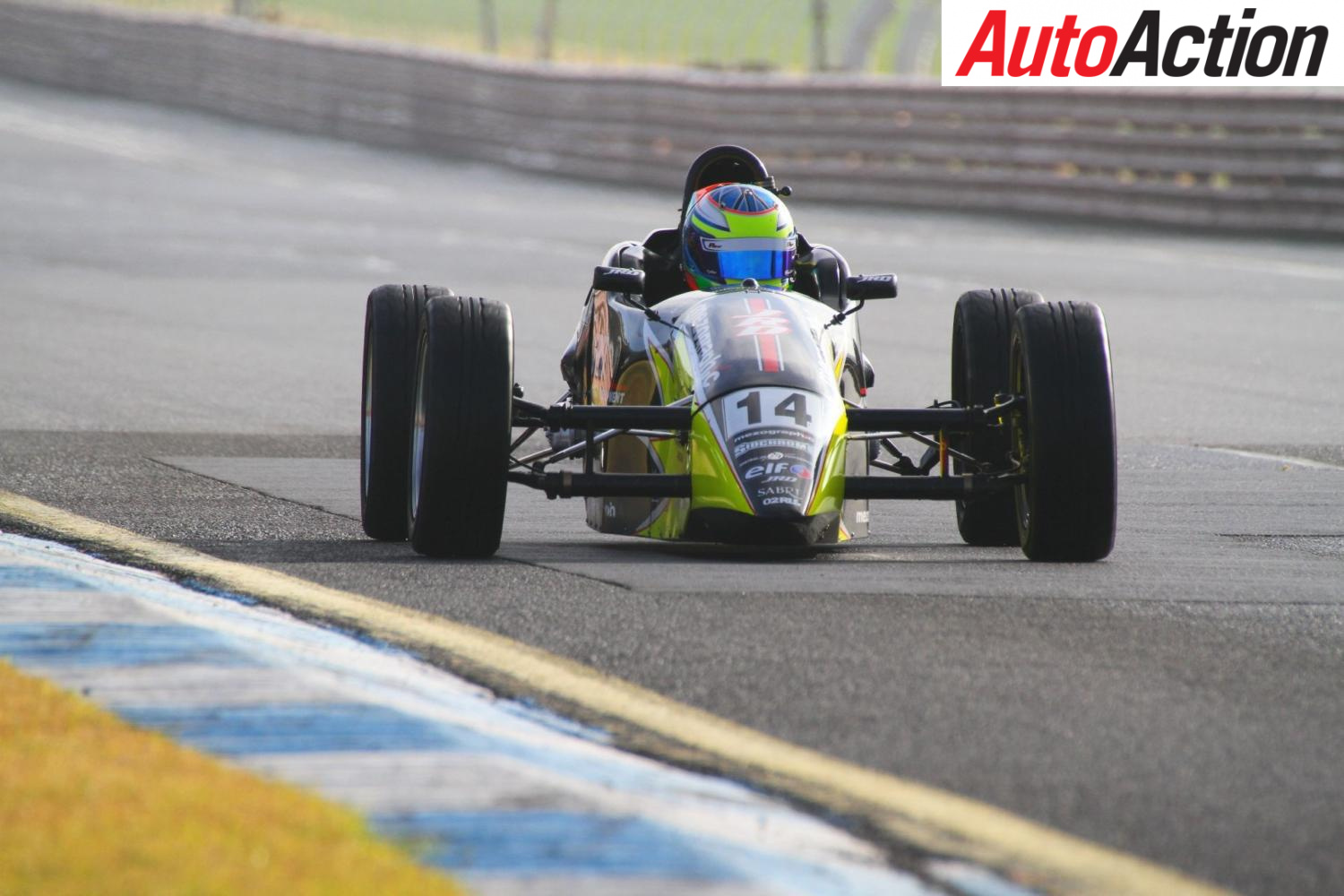
It has been around since the 60’s, but Formula Vee is a proven talent development category, which comes at minimum cost and teaches the basics of racecraft. So, what is all the fuss about?

Junior Racing Developments Sabre Formula Vee on track
YES, REALLY. Formula Vee first foundations can be found in 1959 when a Volkswagen dealer in the US requested a race car that it could sell parts for. Since then, the class has blossomed after the Sports Car Club of America recognised it as a class in 1963, hitting Australian shores in 1965 with much success.
A variety of chassis manufacturers including Jacer, Polar, Elfin, Stinger and Acman grace the Formula Vee grid in a combined field of older 1200cc machinery and the newer 1600cc machinery that was introduced in 2004. One name, however, stands out and that is Sabre.
The Sabre chassis has been popular with competitors since it was first introduced in 1993. The Sabre chassis is currently designed and built by Mike Borland of Borland Racing Developments in the outer-eastern suburbs of Melbourne. More known for his work on Chris Lambden’s Formula Thunder 5000 and the successful incarnations of the Spectrum Formula Ford, the Sabre 02 has also been a victorious after being debuted in 2010.

The Brett McLennan-led Junior Racing Developments team have experienced a great deal of success in the formula currently with James Dean, Heath Collinson and Matt Holmes leading the driver line-up. This has been recognised as JRD are a satellite team to Borland and look after the Sabre competitors on a race weekend, similar to how Porsche have its Customer truck at Carrera Cup meetings.
JRD’s lead mechanic is Mick Reinhardt, a last name that may sound similar some astute follows of the junior formulas. Reinhardt’s son Daniel was a very handy racer winning the Australian Formula Vee Nationals in 2010, a year he won his second Victorian Formula Vee title after winning in 2008. Reinhardt Senior has been around Formula Vees for 25 years and is still extremely enthusiastic about the class.

Formula Vee engine
The class is heavily regulated to keep it as cost effective as possible and despite moving to a 1600cc Beetle motor it remains as cost effective as it gets as Reinhardt explained.
“The engines have just been updated and are running a counterweight crank as opposed to a normal type crank,” explained Reinhardt. “The Formula Vee Association have opened up the conrods now so you can use good quality conrods now, which use ARP bolts.
“In the regulations, everything has minimum weights and so forth that we have to abide by. Cylinder heads are controlled in the sense of there is no porting permitted and we may only have three angles on the valve seat for arguments sake and no more. In addition, we have to run a restrictor plate, so the engine itself will only take as much as the restrictor plate allows.
“The restrictor plate is really the main governing factor on a Formula Vee.”
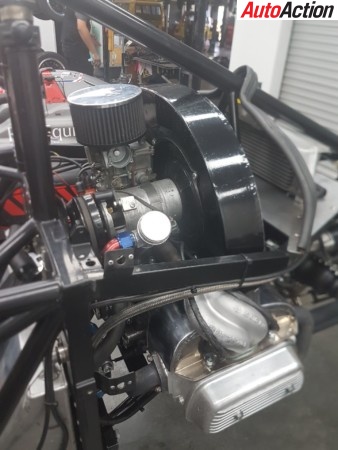
The cars are quite basic to minimise the expense needed to run them. Though the price of a new Vee is around $60,000, if maintained properly it can be run rather inexpensively.
“The carburettor is all standard, apart from jetting,” continued Reinhardt. “We are not allowed to polish it, we are not allowed to do anything to the carburettor, same as the manifold it is really untouched.
Updates have been introduced to the Vees gradually over the seasons, but the car still retains its simplicity and makes an ideal starting point for a young driver to learn how to both drive and maintain a race car.
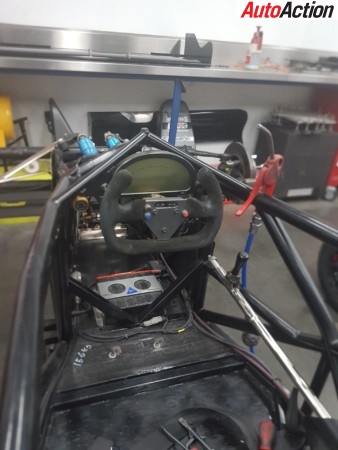
“We don’t run an electrical system at all, they run purely of the battery and there’s no charging system, we are reliant on battery voltage,” Reinhardt said.
“They’ve opened up electronic ignition, those are the things that we have been updating.”
Reinhardt eluded to a problem that maybe eradicated in the near future.
“We’re not dry-sumped, so we really have to baffle the engines quite severely, but we’re finding as the speeds increase and everything else is increased, obviously the engines screaming to get the oil back down, this maybe another change that come in the future.”
The gearbox is a VW four-speed that features in the 1600 Beetle, it has fixed ratios and is a sealed item, though modifications can be that are reliability based.
“We use a VW 1600 gearbox, the tallest ratio you can get for these, once again that’s a sealed item, so there’s no polishing the gears or any of that sort of thing. There are a few things that you are allowed to do obviously and that’s just strengthening and welding gears to stop them from spinning, but in general everything is stock, so that would be out of a 1600 Beetle. Because there aren’t that many around, they are becoming difficult to acquire.”
The lack of parts is just starting to become an issue, with replacement parts costing significantly more than a few years ago. Even so, compared to other classes of motorsport, Formula Vee can still claim to be one of the cheaper classes if the inevitable failure or accident occurs.
“We used to be able to buy a transmission for 50 bucks, now we’re buying a transmission for $600 and that’s probably not too bad in the reality of it all,” said Reinhardt philosophically. “If I go and buy one axle it’s nearly $200 to get it here. Other competitors will still venture to try and find these things and still pay what’s required because it’s too hard, and quite expensive to import these things. In the grand scheme of things, if that axle cost you $200 and you bent an axle tube or bent an axle, you’re damage bill might be $1000. It’s quite a lot less than a Formula Ford would be and stronger. It will take a lot heavier a knock than what a Ford would.”
Despite the price creeping, the longevity of the parts is very strong if maintained. JRD undertake an inspection of the ‘big end’ as it suffers from a bit of surge, while a service of the ‘top end’ of takes place after four rounds.
“If it’s a good solid engine and well maintained you can get some solid mileage out of it, but most of the stuff is top end stuff, whether it be pistons and rings, we’ll just re-hone them and re-ring them,” Reinhardt stated.
“We can do that for another four times before you’re up for another set of barrels, but a set of pistons and a set of barrels will set you back $500 for a good quality set.”
Other small gains can be made in the engine by simply loosening or tightening the fanbelt, amongst other things.
“An early 1200 fan would only have 13 blades, but they’re the sort of performance gain teams look for. Some would have 12 blades as opposed to that and obviously that provides less resistance and doesn’t rob as much horsepower.”
“The fanbelt is loose, but as the car locks in it tightens, so we would run a speed sensor to see how fast its spinning, see if it’s okay and maybe check it into how hot the engine is going, so we can see if we need to tighten or loosen the fanbelt. This alone is worth 5hp.”
To minimise the drag produced by the Sabre, the team at Borland have utilised one shock absorber for the rear of the car, while the front features a pair of in-board Penske shockers. The rear uses what’s called a zero roll and utilises a pivot point to aid in its handling and the front features an internal swaybar making set-up relatively easy.
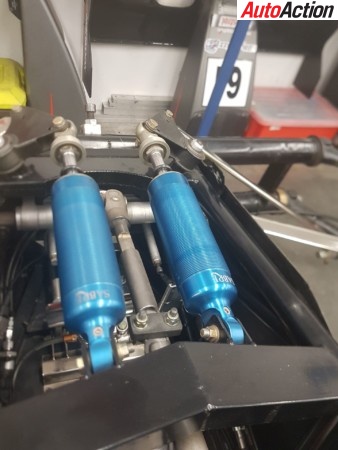
“It’s pretty simple to set one of these up,” concurred Reinhardt. “You can change the caster and the camber, you’re a little bit restricted in how much caster you can put in, but we do have new centric adjusters, which allows us to put a lot more camber into them. We can also introduce some camber by changing the width of the shim at the front, but obviously you can only do that to a certain degree. Any other movement would be a require a complete movement of the beam. There is already caster built onto the chassis and we usually run a 5mm shim underneath.”
“In a car two left packs are used, but if we put two left packs the Vee would be sitting up too high and we wouldn’t be able to get the thing down. Hence that’s why the swaybar gets fitted internally with one adjustable leaf pack.”

Volkswagen Beetle disc brakes are utilised on the front in what is again a very strict set of rules and regulations, which include the weight of the components. Nissan Skyline discs are used on the rear. The improvements to the Vee have also taken into account the accessibility of parts, providing teams with easy ways to access the parts needed.
“With this car we’ve designed it so that all the parts can bought off the shelf and it’s not too difficult,” Reinhardt explained. “They are just basically a Beetle caliper and a Beetle disc on the front and early Skyline on the rear. Not real expensive, the rotors are $100, $55 and the pads are $50, so running costs compared to a Ford are a lot cheaper and the other thing is you’ll probably do four-five race meetings on one set of pads.
“You might do one set a season.”
Tyres are also lasting after the class changed to Yokohama this year.
“We ran the full season on the same set of tyres, that’s the first time we’ve done that,” Reinhardt enthused. “The Yokohamas are different, it’s a radial tyre and we’ve never previously raced on radials, we always used to race on cross-plies.”
What many competitors have found is that due to the increased grip from the tyres, some components that have been made out of a weaker material are failing. This hasn’t affected JRD’s fleet of Sabres.
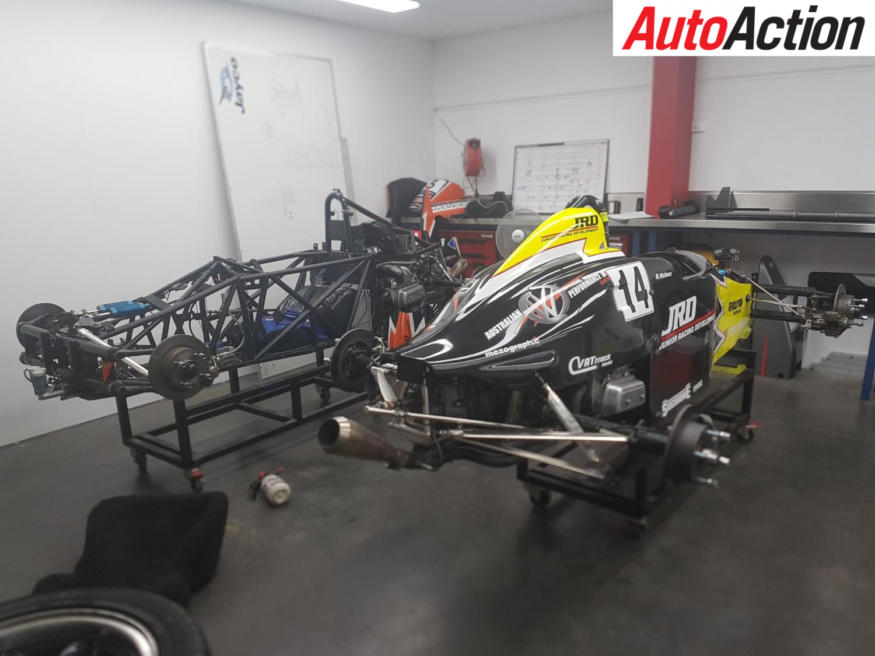
The chassis is based on a Spectrum Formula Ford, which comprises the mid-section of the body. The advancement in chassis design can be seen when compared to an older car as the boxing and tubing, which were predominate features in Formula Vees, has been removed.
The design of the moly-steel chassis has been centred around being as compact as possible to aid with the Aerodynamics, which has been the biggest developing factor in Formula Vee.
“Because we’re so restricted the other governing thing is Aero. Comparing old to new, the older model is wide and so much air is being pushed, while the new car slices through and will naturally go faster down a straight.”
“The main aim of those cars was to slim everything down.”
“Now we’re all on ball joint front ends and we’ve cut all the towers off, so we’ve tried to move everything into the body that’s why we run in-board shockers. Back in the day that was all in the open.”
The fibreglass body was designed, with some input from JRD, by Borland. Replacement body parts are not a problem as each panel can be purchased through Borland or JRD, unlike some of the early homemade specials that frequent the category, even in current day. Previously it wasn’t like that and custom body panels had to be made at great expense to the competitor.
“It’s one of those cars that I can buy a nosecone, I can buy a bonnet, I can buy a middle section and a rear section for it, but previously it wasn’t like that,” Reinhardt explained. “Bodywise, they are unable to be updated, but mechanically it can be updated and as well as suspension.”
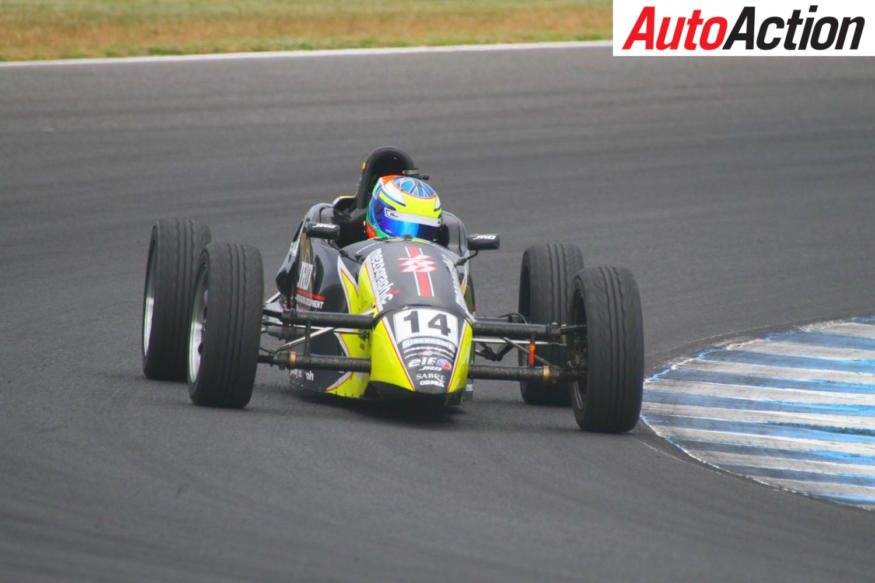
MoTec provide the data logging system and gauges, which Reinhardt believes is a great aid to the young kids that jump into racing from a kart.
“We’re running MoTec, but it is personal choice. [It] Could be an AIMS system, could be a MoTec. All Sabres come with a MoTec because if we have a problem MoTec are local and it’s something we can buy fairly easily, and keep in our spare parts range. We would keep an oxy-sensor in there [spare parts], it would be just a matter of taking it out and replacing it.
“This is mainly measuring engine performance I terms of oil temp, fan speed, but it’s not controlling ignition because we are not allowed to do that. Steering angle, brake bias, brake pressure are factors that we can dial up, which we download and becomes a great universal tool for the kids.”
The class is one that has produced drivers such as Supercars drivers Jack Le Brocq and Cameron Waters, and even looking back further F1 drivers Larry Perkins, Keke Rosberg, Niki Lauda and Emerson Fittipaldi.
The tactics and racecraft that Formula Vee provide is nothing like anything else out there. It provides a perfect stepping stone from karts and the racing is nothing short of spectacular, especially at circuits like Phillip Island and Sandown. But what are they like to drive? Reinhardt concluded.
“It’s the best drafting class out there it’s more like 125cc bikes. It’s all tactical, drivers think about where they position themselves and test each other on the exit and in the slipstream to determine if the can win or not.”
“They’re awesome. If you can drive a Formula Vee at the front of the field, I believe you could go fast in any type of car, so it’s a great teaching car.”
TECH DETAILS – SABRE 02
Engine: Volkswagen Beetle 1600cc
Power: 70-75hp
Dimensions
Length: 3525mm
Width: F: 1625
R: 1635
Wheelbase: 2220mm
Chassis: Moly-steel cage, TIG welded
Weight: 515kg approx. (category minimum)
Transmission: Volkswagen four-speed gearbox
Brakes: F: Volkswagen discs
R: Nissan Skyline discs
Four-wheel disc brakes
Suspension
F: Penske shocks, internal swaybar,
R: 1 Penske shock, zero roll pivot point suspension
Tyres: Yokohama F: 185/55R15
R: 195/55R15
Electronics: MoTec data logging system
Body: Aerodynamically designed fibreglass body panels
By HEATH McALPINE
Article originally published in Issue 1725 of Auto Action.
For our latest Under The Skin feature pick up the current issue of Auto Action Magazine, on sale now. In the meantime follow us on social media Facebook, Twitter, Instagram or sign up for our weekly email newsletter for all the latest updates.


